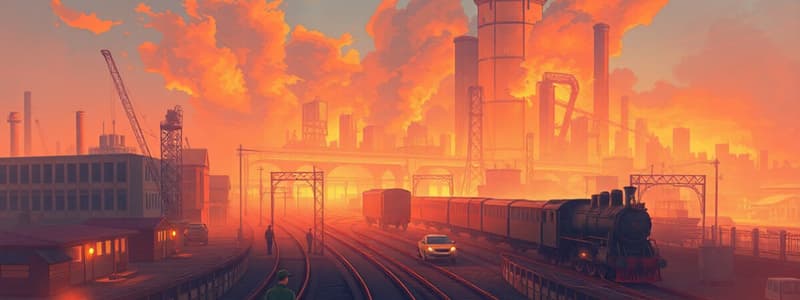Podcast
Questions and Answers
How did the development of the locomotive primarily affect England's industrial growth?
How did the development of the locomotive primarily affect England's industrial growth?
- It led to a decrease in demand for agricultural products in urban centers.
- It decreased the cost of transporting goods and materials, thereby boosting manufacturing. (correct)
- It made it more expensive for rural populations to find work in distant cities.
- It reduced the number of available jobs in the mining and railroad industries.
What was the primary cause of the shift in population from rural areas to urban centers in Europe after 1800?
What was the primary cause of the shift in population from rural areas to urban centers in Europe after 1800?
- Increased agricultural productivity that reduced the need for farm labor.
- Government policies that favored urban development over rural economies.
- The growth of the factory system, which concentrated manufacturing in cities. (correct)
- A decline in rural living standards due to environmental degradation.
How did the turnpike system finance road improvements during increased trade in England?
How did the turnpike system finance road improvements during increased trade in England?
- By receiving direct subsidies from Parliament based on trade volume.
- By collecting tolls from road users, which funded repairs and upgrades. (correct)
- By requiring local governments to allocate property taxes to road maintenance.
- By imposing a national sales tax on all manufactured goods.
What was the main reason for the increased use of canals during the manufacturing boom?
What was the main reason for the increased use of canals during the manufacturing boom?
How did the invention of the locomotive influence employment opportunities in England?
How did the invention of the locomotive influence employment opportunities in England?
Flashcards
Turnpikes
Turnpikes
Roads that required users to pay tolls. The tolls were used to pay for road repairs and upgrades.
Canals
Canals
Man-made waterways used for transportation, connecting to larger bodies of water.
Urbanization
Urbanization
City building and the movement of people to cities.
Locomotive
Locomotive
Signup and view all the flashcards
Rural to Urban Shift
Rural to Urban Shift
Signup and view all the flashcards
Study Notes
- Prior to the locomotive, horseback was the fastest overland travel method, averaging 30 mph.
- Horseback travel was uncomfortable, required frequent stops, and had limited carrying capacity.
- George Stephenson's locomotive, Rocket, could travel at 29 mph by 1829.
- Locomotives needed fuel like coal and could pull massive loads.
- English entrepreneurs wanted a railroad line connecting Liverpool and Manchester.
- Railroads encouraged industrial growth by providing a cheap way to transport materials and finished products.
- The railroad boom created hundreds of thousands of jobs for railroad workers and miners.
- Railroads boosted England’s agriculture by facilitating product transport to cities.
- Railroads made travel easier, encouraging people to take distant city jobs.
Urbanization
- Before 1800, most Europeans lived in rural areas.
- After 1800, the population balance shifted toward cities due to the growth of the factory system.
- Manufacturing of goods was concentrated in a central location through the factory system.
- Between 1800 and 1850, European cities with over 100,000 inhabitants rose from 22 to 47.
- Most of Europe’s urban areas at least doubled in population during this period.
- Factories developed in clusters near energy sources like water and coal.
- London had a population of about one million people by 1800, providing a large labor pool and market.
- Manchester became a dominant textile manufacturing city.
Turnpikes and Canals
- Increased trade led to the need for better roads.
- The English Parliament allowed local governments to create turnpikes, roads requiring tolls.
- Tolls were used to pay for road repairs and upgrades.
- A pike was a barrier across the road, lifted after payment.
- Canals are man-made waterways that connect to larger bodies of water.
- Increased manufacturing created a demand to transport heavy fuel and products.
- Transporting over land became less effective.
- Large canal systems were built throughout England and other countries.
- Steam could propel boats.
- An American inventor named Robert Fulton built a steamboat called the Clermont.
Studying That Suits You
Use AI to generate personalized quizzes and flashcards to suit your learning preferences.




